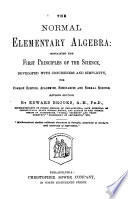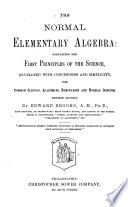 | Edward Brooks - Algebra - 1888 - 344 pages
...members of an equation. 3. Bath members of an equation may be multiplied by ike same or equal quantities. 4. Both members of an equation may be divided by the same or equal quantities. 5. Both members of an equation may be raised to the same power. 6. Both members... | |
 | Edward Brooks - Algebra - 1888 - 190 pages
...members of an equation. 3. Both members of an equation may be multiplied by the same or equal quantities. 4. Both members of an equation may be divided by the same or equal quantities. 5. Both members of an equation may be raised to the same power. 6. Both members... | |
 | Webster Wells - Algebra - 1908 - 262 pages
...an equation may be multiplied by the same number, or equal numbers, without destroying the equality. 4. Both members of an equation may be divided by the same number, or equal numbers, without destroying the equality. 77. Transposing Terms. — Consider the equation... | |
 | Webster Wells - Algebra - 1908 - 456 pages
...an equation may be multiplied by the same number, or equal numbers, without destroying the equality. 4. Both members of an equation may be divided by the same number, or equal numbers, without destroying the equality. 77. Transposing Terms. — Consider the equation... | |
 | Webster Wells, Walter Wilson Hart - Algebra - 1912 - 504 pages
...numbers, the quotients are equal. This fact is used in algebr^ in the following form : Ф Rule. — Both members of an equation may be divided by the same number without destroying the equality. EXAMPLE. Solve the equation : 36 k = 468. SOLUTION: 1. Since k is j1^ of 36 k, divide both members... | |
 | James Charles Byrnes, Julia Richman, John Storm Roberts - Arithmetic - 1913 - 468 pages
...may be MULTIPLIED by the same number without affecting the equality. Fourth Principle of the Equation Both members of an equation may be DIVIDED by the same number without affecting the equality. EXERCISES 407. Solve each equation. (Prove those marked *.) = 10. 10. z-2 =... | |
 | James Charles Byrnes, Julia Richman, John Storm Roberts - Arithmetic - 1913 - 552 pages
...may be MULTIPLIED by the same number without affecting the equality. Fourth Principle of the Equation Both members of an equation may be DIVIDED by the same number without affecting the equality. EXERCISES 207. Solve each equation. (Prove those marked *.) *i. x + 5 = 10... | |
 | Charles Gerard White, Pitt Payson Colgrove - Arithmetic - 1916 - 368 pages
...(3) Both members of an equation may be multiplied by the same number without destroying its equality. (4) Both members of an equation may be divided by the same number without destroying its equality. 179. In the equation, x + 8 = 11, point out the lefthand member, the right-hand member,... | |
 | Samuel Hamilton - Arithmetic - 1917 - 410 pages
...equality. Both members of an equation may be multiplied by the same number without destroying the equality. Both members of an equation may be divided by the same number without destroying the equality. Knowing these facts and employing letters to represent quantities whose value is unknown, you can,... | |
 | Harry Morton Keal - Mathematics - 1917 - 148 pages
...equation, 3x=10, X = 3j, (dividing both members by 3) 5 From this explanatory problem, it will be seen that both members of an equation may be divided by the same number. Oral Problems: Solve for x : 1. 4x=12 2. 2x=16 3. 5x = 9 4. llx = 33 6. l.lx=12.1 Example: Solve for... | |
| |